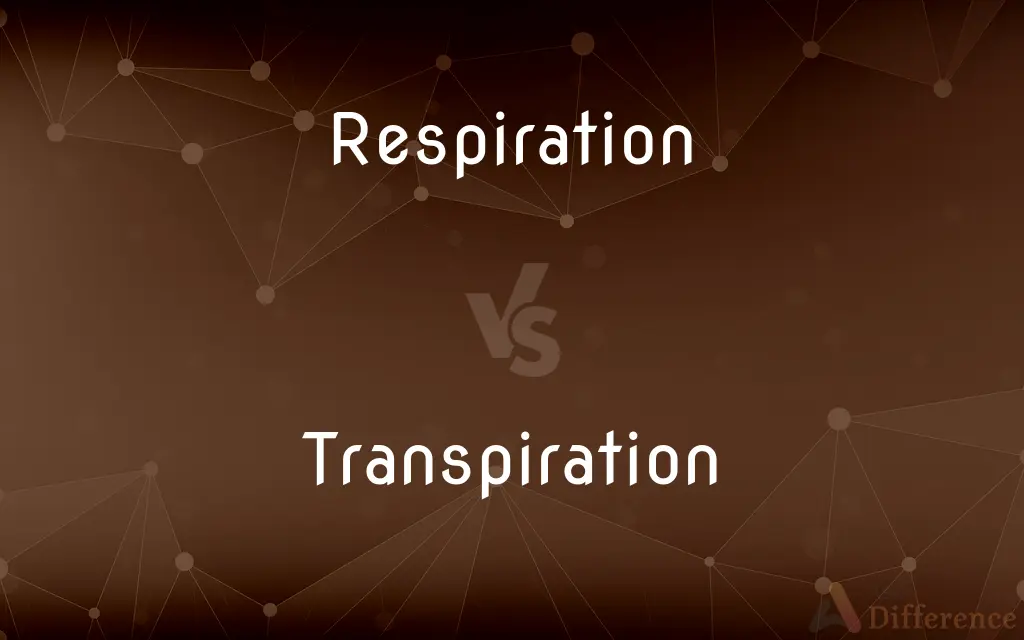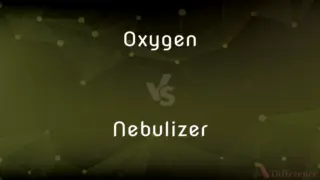Respiration vs. Transpiration — What's the Difference?
By Fiza Rafique & Urooj Arif — Updated on March 28, 2024
Respiration is the process by which living organisms convert oxygen and glucose into energy, carbon dioxide, and water. Transpiration is the evaporation of water from the aerial parts of plants, mainly through the stomata of leaves.

Difference Between Respiration and Transpiration
Table of Contents
ADVERTISEMENT
Key Differences
Respiration is a metabolic process occurring in all living organisms, including plants, animals, and microbes, essential for producing energy required for biological activities. It involves the intake of oxygen and the release of carbon dioxide as a byproduct. On the other hand, transpiration is a process specific to plants, especially through their leaves, playing a crucial role in the water cycle by releasing water vapor into the atmosphere.
The primary purpose of respiration is to generate ATP (adenosine triphosphate), which serves as the main energy currency in cells, supporting various functions such as growth, repair, and maintenance. Conversely, transpiration's main role is to regulate temperature within plant tissues and assist in nutrient uptake and transport throughout the plant.
Respiration occurs in the mitochondria of cells through a series of biochemical reactions, divided into aerobic (with oxygen) and anaerobic (without oxygen) respiration. Transpiration, however, takes place mainly through the stomata, small openings on the underside of leaves, and is influenced by environmental factors like humidity, temperature, and wind.
While both processes involve gas exchange, respiration's exchange is primarily for metabolic activities, and transpiration's gas exchange is incidental to water vapor loss. Additionally, respiration occurs continuously throughout the life of the organism, while transpiration rates can vary based on the plant's environmental conditions.
The mechanisms underlying these processes also differ significantly. Respiration involves the breakdown of glucose and the use of oxygen to produce energy, while transpiration involves the physical process of water movement through the plant and its evaporation from aerial parts.
ADVERTISEMENT
Comparison Chart
Definition
Metabolic process converting oxygen and glucose into energy, CO2, and water.
Evaporation of water from plant parts, mainly leaves.
Primary Function
Produces ATP for energy.
Regulates temperature, assists in nutrient uptake.
Occurs In
All living organisms.
Plants.
Location
Mitochondria (in cells).
Stomata (on leaves).
Purpose
Energy production for biological activities.
Temperature regulation, nutrient transport.
Process Type
Biochemical reactions.
Physical process (water movement and evaporation).
Gas Exchange
Oxygen in, carbon dioxide out.
Incidental to water vapor release.
Environmental Influence
Less direct, primarily affects rate.
Directly influenced by humidity, temperature, wind.
Variability
Continuous, consistent rate.
Variable, dependent on environmental conditions.
Compare with Definitions
Respiration
The process of breaking down glucose for energy.
Human cells undergo respiration to maintain vital functions.
Transpiration
Mainly occurs through leaf stomata.
The opening of stomata facilitates transpiration in leaves.
Respiration
Involves oxygen intake and CO2 release.
Plants respire at night, absorbing oxygen and releasing carbon dioxide.
Transpiration
Water vapor loss from plant surfaces.
On sunny days, transpiration rates in plants can be high.
Respiration
Generates ATP for cellular activities.
Muscle cells demand more ATP during exercise, increasing respiration.
Transpiration
Influences by environmental factors.
Windy conditions can increase transpiration rates.
Respiration
Occurs in all living organisms.
Even single-celled organisms rely on respiration for energy.
Transpiration
Regulates plant temperature.
Transpiration helps cool plants on hot days.
Respiration
Essential for survival and growth.
Without respiration, cells cannot perform basic metabolic functions.
Transpiration
Part of the water cycle.
Transpiration contributes to cloud formation and precipitation.
Respiration
The action or process of inhaling and exhaling; breathing. Also called ventilation.
Transpiration
Transpiration is the process of water movement through a plant and its evaporation from aerial parts, such as leaves, stems and flowers. Water is necessary for plants but only a small amount of water taken up by the roots is used for growth and metabolism.
Respiration
An act of inhaling and exhaling; a breath.
Transpiration
The act or process of transpiring, especially through the stomata of plant tissue or the pores of the skin.
Respiration
The action or process by which an organism without lungs, such as a fish or plant, exchanges gases with its environment.
Transpiration
(botany) The loss of water by evaporation in terrestrial plants, especially through the stomata; accompanied by a corresponding uptake from the roots.
Respiration
The oxidative process occurring within living cells by which the chemical energy of organic molecules is converted in a series of metabolic steps into usable energy in the form of ATP, involving the consumption of oxygen and the production of carbon dioxide and water as byproducts.
Transpiration
(physiology) The process of giving off water vapour through the skin or mucous membranes.
Respiration
Any of various analogous metabolic processes by which certain organisms, such as anaerobic bacteria and some fungi, obtain energy from organic molecules without consuming oxygen.
Transpiration
The passage of gases through fine tubes.
Respiration
The process of inhaling and exhaling; breathing, breath.
Transpiration
The act or process of transpiring or excreting in the form of vapor; exhalation, as through the skin or other membranes of the body; as, pulmonary transpiration, or the excretion of aqueous vapor from the lungs. Perspiration is a form of transpiration.
Respiration
An act of breathing; a breath.
Transpiration
The evaporation of water, or exhalation of aqueous vapor, from cells and masses of tissue.
Respiration
Any similar process in an organism that lacks lungs that exchanges gases with its environment.
Transpiration
The passing of gases through fine tubes, porous substances, or the like; as, transpiration through membranes.
Respiration
The process by which cells obtain chemical energy by the consumption of oxygen and the release of carbon dioxide.
Transpiration
The passage of gases through fine tubes because of differences in pressure or temperature
Respiration
The act of respiring or breathing again, or catching one's breath.
Transpiration
The process of givng off or exhaling water vapor through the skin or mucous membranes
Respiration
Relief from toil or suffering: rest.
Till the dayAppear of respiration to the justAnd vengeance to the wicked.
Transpiration
The emission of water vapor from the leaves of plants
Respiration
Interval; intermission.
Respiration
The act of resping or breathing; the act of taking in and giving out air; the aggregate of those processes bu which oxygen is introduced into the system, and carbon dioxide, or carbonic acid, removed.
Respiration
A single complete act of breathing in and out;
Thirty respirations per minute
Respiration
The bodily process of inhalation and exhalation; the process of taking in oxygen from inhaled air and releasing carbon dioxide by exhalation
Common Curiosities
How do respiration and transpiration differ in their primary functions?
Respiration's primary function is to produce energy for cellular activities, while transpiration regulates plant temperature and aids in nutrient transport.
Can plants undergo both respiration and transpiration?
Yes, plants carry out both processes: respiration for energy production and transpiration for water regulation and nutrient transport.
What is respiration?
Respiration is a metabolic process where organisms convert oxygen and nutrients into energy, releasing carbon dioxide and water.
Why is respiration important for all living organisms?
Respiration is crucial for producing ATP, the energy needed for growth, repair, and maintenance of biological functions.
How does the environment affect transpiration?
Environmental factors like temperature, humidity, and wind speed directly influence the rate of transpiration in plants.
What is transpiration?
Transpiration is the process by which water evaporates from the aerial parts of plants, mainly through stomata in the leaves.
Is transpiration a form of respiration?
No, transpiration is a separate process primarily involved in water movement and evaporation, not in energy production.
What roles do stomata play in transpiration?
Stomata are small openings on leaf surfaces that allow water vapor to escape, facilitating transpiration.
How is respiration related to photosynthesis?
While photosynthesis converts carbon dioxide and sunlight into oxygen and glucose, respiration uses oxygen and glucose to produce energy, carbon dioxide, and water.
What happens to plants when transpiration is inhibited?
Inhibiting transpiration can lead to overheating, reduced nutrient transport, and potentially harm the plant's growth and health.
How do organisms perform respiration without oxygen (anaerobic respiration)?
In the absence of oxygen, some organisms can perform anaerobic respiration, breaking down glucose into energy, producing substances like alcohol or lactic acid instead of carbon dioxide and water.
What is the significance of transpiration in the water cycle?
Transpiration contributes to the water cycle by releasing water vapor into the atmosphere, which can then form clouds and precipitation.
What is the ecological importance of transpiration?
Ecologically, transpiration plays a key role in maintaining moisture levels in the atmosphere and influencing weather and climate patterns.
Can the rate of respiration vary?
Yes, the respiration rate can vary depending on the organism's activity level, oxygen availability, and other factors.
Are there any adaptations plants have to reduce transpiration?
Yes, some plants have adaptations like waxy leaf coatings, reduced leaf surface area, and closed stomata during hot conditions to reduce water loss.
Share Your Discovery

Previous Comparison
Beg vs. Please
Next Comparison
Oxygen vs. NebulizerAuthor Spotlight
Written by
Fiza RafiqueFiza Rafique is a skilled content writer at AskDifference.com, where she meticulously refines and enhances written pieces. Drawing from her vast editorial expertise, Fiza ensures clarity, accuracy, and precision in every article. Passionate about language, she continually seeks to elevate the quality of content for readers worldwide.
Co-written by
Urooj ArifUrooj is a skilled content writer at Ask Difference, known for her exceptional ability to simplify complex topics into engaging and informative content. With a passion for research and a flair for clear, concise writing, she consistently delivers articles that resonate with our diverse audience.















































